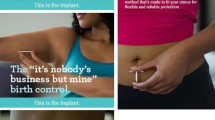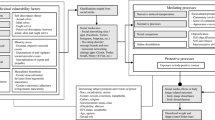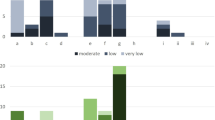Abstract
Because use of geosocial-networking smartphone applications (‘apps’) is ubiquitous among men who have sex with men (MSM), online-to-offline service models that include advertisements on these apps may improve engagement with effective HIV prevention and treatment services. Through our formative qualitative study, we conducted individual in-depth interviews (n = 30) and focus group discussions (n = 18) with MSM in Rhode Island to develop a digital social marketing campaign aimed at increasing HIV testing, including how best to reach men by advertising on apps. Qualitative data analysis revealed that participants were frequently exposed to pop-up advertisements on apps. These advertisements are viewed as invasive and, as such, many expressed a preference for other formats (e.g., direct messages, banner advertisements). Men expressed a preference for provocative images and phrases to catch their attention followed with fact-driven messaging to motivate them to engage with services offline. Findings from this study offer several practical recommendations for developing a social marketing campaign that uses advertisements on apps to increase HIV testing among MSM, including using formats other than pop-up advertisements and pairing fact-driven messaging with eye-catching images to direct them to trusted local clinical services.
Similar content being viewed by others
References
Grey JA, Bernstein KT, Sullivan PS, Purcell DW, Chesson HW, Gift TL, et al. Estimating the population sizes of men who have sex with men in US states and counties using data from the American Community Survey. JMIR Public Health Surveill. 2016;2(1):e14.
Centers for Disease Control and Prevention. Diagnoses of HIV Infection in the United States and Dependent Areas, 2017. Atlanta, Georgia: National Center for HIV/AIDS, Viral Hepatitis, Sexually Transmitted Diseases, and Tuberculosis Prevention; 2018.
Singh S, Song R, Johnson AS, McCray E, Hall HI. HIV incidence, prevalence, and undiagnosed infections in US men who have sex with men. Ann Intern Med. 2018;168(10):685–94.
Hess KL, Hu X, Lansky A, Mermin JH, Hall HI. Lifetime risk of a diagnosis of HIV infection in the United States. Ann Epidemiol. 2017;27(4):238–43.
National HIV/AIDS Strategy for the United States: updated to 2020 Washington, District of Columbia: The White House Office of National AIDS Policy; 2015.
Myers JE, Braunstein SL, Xia Q, Scanlin K, Edelstein Z, Harriman G, et al. Redefining prevention and care: a status-neutral approach to HIV. Open Forum Infect Dis. 2018;5(6):ofy097.
United States Preventive Services Task Force. Screening for HIV infection: US Preventive Services Task Force recommendation statement. JAMA. 2019.
Centers for Disease Control and Prevention. HIV Infection Risk, Prevention, and Testing Behaviors Among Men Who Have Sex With Men, National HIV Behavioral Surveillance, 23 U.S. Cities, 2017. Atlanta, Georgia: National Center for HIV/AIDS, Viral Hepatitis, Sexually Transmitted Diseases, and Tuberculosis Prevention; 2019.
Clark HA, Oraka E, DiNenno EA, Wesolowski LG, Chavez PR, Pitasi MA, et al. Men who have sex with men (MSM) who have not previously tested for HIV: results from the MSM Testing Initiative, United States (2012–2015). AIDS Behav. 2019;23(2):359–65.
Macapagal K, Moskowitz DA, Li DH, Carrión A, Bettin E, Fisher CB, et al. Hookup app use, sexual behavior, and sexual health among adolescent men who have sex with men in the United States. J Adolesc Health. 2018;62(6):708–15.
DeVost MA, Beymer MR, Weiss RE, Shover CL, Bolan RK. App-based sexual partner seeking and sexually transmitted infection outcomes: a cross-sectional study of HIV-negative men who have sex with men attending a sexually transmitted infection clinic in Los Angeles, California. Sex Transm Dis. 2018;45(6):394–9.
Beymer MR, Weiss RE, Bolan RK, Rudy ET, Bourque LB, Rodriguez JP, et al. Sex on demand: geosocial networking phone apps and risk of sexually transmitted infections among a cross-sectional sample of men who have sex with men in Los Angeles county. Sex Transm Infect. 2014;90(7):567–72.
Lehmiller JJ, Ioerger M. Social networking smartphone applications and sexual health outcomes among men who have sex with men. PLoS ONE. 2014;9(1):e86603.
Sun CJ, Sutfin E, Bachmann LH, Stowers J, Rhodes SD. Comparing men who have sex with men and transgender women who use Grindr, other similar social and sexual networking apps, or no social and sexual networking apps: implications for recruitment and health promotion. J AIDS Clin Res. 2018;9(2).
Chan PA, Towey C, Poceta J, Rose J, Bertrand T, Kantor R, et al. Online hookup sites for meeting sexual partners among men who have sex with men in Rhode Island, 2013: a call for public health action. Public Health Rep. 2016;131(2):264–71.
Goedel WC, Hickson DA, Duncan DT. Identification and involvement with the gay community among men who have sex with men in Atlanta who use geosocial-networking smartphone applications. J Gay Lesbian Ment Health. 2017;21(3):248–55.
Chan LS. The role of gay identity confusion and outness in sex-seeking on mobile dating apps among men who have sex with men: a conditional process analysis. J Homsex. 2017;64(5):622–37.
Anand T, Nitpolprasert C, Trachunthong D, Kerr SJ, Janyam S, Linjonngrat D, et al. A novel Online-to-Offline (O2O) model for pre-exposure prophylaxis and HIV testing scale up. J Int AIDS Soc. 2017;20(1):21326.
Gilbert M, Salway T, Haag D, Fairley CK, Wong J, Grennan T, et al. Use of GetCheckedOnline, a comprehensive web-based testing service for sexually transmitted and blood-borne infections. J Med Internet Res. 2017;9(3):e81.
Grier S, Bryant CA. Social marketing in public health. Annu Rev Public Health. 2005;26:319–39.
Wei C, Herrick A, Raymond HF, Anglemyer A, Gerbase A, Noar SM. Social marketing interventions to increase HIV/STI testing uptake among men who have sex with men and male-to-female transgender women. Cochrane Database Syst Rev. 2011;9:CD009337.
Sun CJ, Stowers J, Miller C, Bachmann LH, Rhodes SD. Acceptability and feasibility of using established geosocial and sexual networking mobile applications to promote HIV and STD testing among men who have sex with men. AIDS Behav. 2015;19(3):543–52.
Lampkin D, Crawley A, Lopez TP, Mejia CM, Yuen W, Levy V. Reaching suburban men who have sex with men for std and hiv services through online social networking outreach: a public health approach. J Acquir Immune Defic Syndr. 2016;72(1):73–8.
Huang E, Marlin RW, Young SD, Medline A, Klausner JD. Using Grindr, a smartphone social-networking application, to increase HIV self-testing among Black and Latino men who have sex with men in Los Angeles, 2014. AIDS Educ Prev. 2016;28(4):341–50.
Huang ET-Y, Williams H, Hocking JS, Lim MS. Safe sex messages within dating and entertainment smartphone apps: a review. JMIR mHealth uHealth. 2016;4(4):e124.
Atlas Plus. National Center for HIV/AIDS, Viral Hepatitis, Sexually Transmitted Diseases, and Tuberculosis Prevention. 2017. https://www.cdc.gov/nchhstp/atlas/index.htm.
Haghdoost AA, Karamouzian M. Zero new HIV infections, zero discrimination, and zero AIDS-related deaths: feasible goals or ambitious visions on the occasion of the world AIDS day? Int J Prev Med. 2012;3(12):819–23.
United States Census Bureau. American Community Survey, 2014-2018 summary estimates. Washington, District of Columbia: United States Census Bureau; 2018.
Rosenberg ES, Purcell DW, Grey JA, Hankin-Wei A, Hall E, Sullivan PS. Rates of prevalent and new HIV diagnoses by race and ethnicity among men who have sex with men, US states, 2013–2014. Ann Epidemiol. 2018;28(12):865–73.
Smith DK, Pals SL, Herbst JH, Shinde S, Carey JW. Development of a clinical screening index predictive of incident HIV infection among men who have sex with men in the United States. J Acquir Immune Defic Syndr. 2012;60(4):421–7.
Thomas D. A general inductive approach for analyzing qualitative evaluation data. Am J Eval. 2006;27(6):237–46.
Blas MM, Menacho LA, Alva IE, Cabello R, Orellana ER. Motivating men who have sex with men to get tested for HIV through the Internet and mobile phones: a qualitative study. PLoS ONE. 2013;8(1):e54012.
Drumhiller K, Murray A, Gaul Z, Aholou TM, Sutton MY, Nanin J. “We deserve better!”: perceptions of HIV testing campaigns among Black and Latino MSM in New York City. Arch Sex Behav. 2018;47(1):289–97.
Jones J, Carter B, Wilkerson R, Kramer C. Attitudes toward HIV testing, awareness of HIV campaigns, and using social networking sites to deliver HIV testing messages in the age of social media: a qualitative study of young black men. Health Educ Res. 2019;34(1):15–26.
Iantaffi A, Wilkerson JM, Grey JA, Rosser BRS. Acceptability of sexually explicit images in HIV prevention messages targeting men who have sex with menn. J Homosex. 2015;62(10):1345–58.
Anand T, Nitpolprasert C, Phanuphak N. Online-to-offline models in HIV service delivery. Curr Opin HIV AIDS. 2017;12(5):447–57.
Acknowledgements
This research was funded with support from the Rhode Island Executive Office of Health and Human Services and the National Institutes of Health (F31MH121112; R25MH0832620; R34DA042648).
Author information
Authors and Affiliations
Corresponding author
Additional information
Publisher's Note
Springer Nature remains neutral with regard to jurisdictional claims in published maps and institutional affiliations.
Rights and permissions
About this article
Cite this article
Goedel, W.C., Sutten Coats, C., Sowemimo-Coker, G. et al. Gay and Bisexual Men’s Recommendations for Effective Digital Social Marketing Campaigns to Enhance HIV Prevention and Care Continuity. AIDS Behav 25, 1619–1625 (2021). https://doi.org/10.1007/s10461-020-03078-8
Accepted:
Published:
Issue Date:
DOI: https://doi.org/10.1007/s10461-020-03078-8




